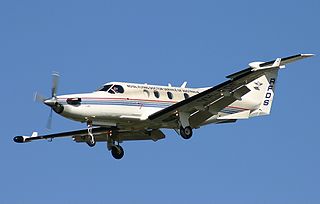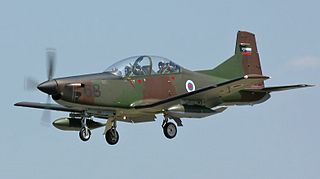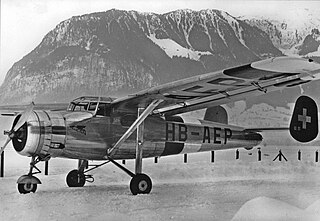Pilatus Aircraft Ltd. is an aerospace manufacturer located in Stans, Switzerland. In June 2016, the company employed 1,905 people.

The Pilatus PC-12 is a pressurized, single-engined, turboprop aircraft manufactured by Pilatus Aircraft of Stans, Switzerland since 1991. It was designed as a high-performance utility aircraft that incorporates a large aft cargo door in addition to the main passenger door. Due to its efficient, high-utility design, the PC-12 is used by a large variety of operators. The main use for the aircraft is corporate transportation, but it is also used by fractional and small regional airlines, air-ambulance operators, and many government agencies, such as police departments and armed forces. The PC-12 is successful with 2,000 deliveries made as of May 2023.

The Pilatus P-3 was a military training aircraft built by Pilatus Aircraft of Switzerland.

The Pilatus PC-9 is a single-engine, low-wing tandem-seat turboprop training aircraft manufactured by Pilatus Aircraft of Switzerland. Designed as a more powerful evolution of the Pilatus PC-7, the PC-9's first flight was made in May 1984 after which certification was achieved in September 1985. After this, the first production orders for the type were received from the Royal Saudi Air Force, with deliveries commencing in 1985. Since then, more than 250 airframes have been produced across five different variants, and the type is employed by a number of military and civilian operators around the world, including the Swiss Air Force, Croatian Air Force, Royal Thai Air Force and the Irish Air Corps

The Pilatus SB-2 Pelican was a civil utility aircraft developped by a purposely founded development bureau at the ETH Zurich on behalf of the Federal Air Authority. In November 1940 it was decided to go on with the project and build the aircraft, in February 1941 the Authority approved the development bureau to have it built at the newly formed Pilatus Aircraft company.

The PZL 130 Orlik is a Polish turboprop, single engine, two seat trainer aircraft.

The Argus As 10 was a German-designed and built, air-cooled 90° cylinder bank-angle inverted V8 "low power" aircraft engine, used mainly in training aircraft such as the Arado Ar 66 and Focke-Wulf Fw 56 Stösser and other small short-range reconnaissance and communications aircraft like the Fieseler Fi 156 Storch during, and shortly after World War II. It was first built in 1928.

The Bücker Bü 133 Jungmeister was an advanced trainer of the Luftwaffe in the 1930s. It was a single-engine, single-seat biplane of wood and tubular steel construction and covered in fabric.

The Bücker Bü 182 Kornett ("Ensign") was a single-seat advanced trainer developed in Germany for Luftwaffe service shortly before the outbreak of World War II.

The Letov Š-28 was a Czechoslovak single-engined, two-seat reconnaissance aircraft. It was manufactured by Letov Kbely in a number of versions with different powerplants. The most important version was the Š-328, which was produced in relatively high quantities.

The Pilatus P-4 was a Swiss five-seat cabin monoplane designed and built by Pilatus, but had little sales success.

The Sablatnig N.I was a bomber aircraft developed in Germany during the First World War, a development of the Sablatnig C.I adapted for night operations.

The Dornier Do E was a small German flying boat of 1924, designed for reconnaissance missions.
The Rolls-Royce/MAN Turbo RB.153 was a high-performance 6,850 pounds-force (3,110 kgf) dry thrust turbofan engine developed jointly by Rolls-Royce Limited and MAN Turbo. Developed for the German EWR VJ 101D interceptor with a German-developed thrust-deflector system. The engine was also proposed for a number of other military VTOL projects including the Hawker P.1157 and Dornier Do 31. A commercial-version of the engine was also considered for the Messerschmitt Me P.160 airliner. The VJ101D project was cancelled and the engine never flew, being retained as a test bed.

The Pilatus PC-8D Twin Porter was a Swiss ten-seat light transport built by Pilatus Aircraft. The type did not go into production and only one was built.

The Pilatus P-5 was a single-engined artillery observation aircraft project from Pilatus Aircraft in Switzerland.
The Pilatus PC-10 was the common name of different designs for a twin-engine aircraft manufacturer Pilatus Aircraft, but none of them reached the production stage.

The Pilatus PC-24 is a light business jet produced by Pilatus Aircraft of Switzerland. Following the success of the PC-12 single engine turboprop, work on the twin engine jet began in 2007 for greater range and speed, keeping the rugged airfield capability. The aircraft was introduced on 21 May 2013 and rolled out on 1 August 2014, with the maiden flight on 11 May 2015. The PC-24 received EASA and FAA type certification on 7 December 2017 and the first customer delivery was on 7 February 2018. Powered by two Williams FJ44 turbofans, it competes with the Embraer Phenom 300 and the Cessna Citation CJ4.

The Blohm & Voss P 170 was a three-engined unarmed fast bomber and ground-attack aircraft project proposed by the aircraft manufacturer Blohm & Voss to the Luftwaffe during the Second World War.

The Zeppelin D.I, or Zeppelin-Lindau D.I or Zeppelin D.I (Do), as named in German documents, also sometimes referred to postwar as the Dornier D.I or Dornier-Zeppelin D.I, for the designer, was a single-seat all-metal stressed skin monocoque cantilever-wing biplane fighter, developed by Claude Dornier while working for Luftschiffbau Zeppelin at their Lindau facility. It was too late to see operational service with the German Air Force (Luftstreitkräfte) during World War I.

















